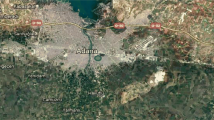Abstract
Imidacloprid (C9H10ClN5O2) is used as the most recommended type of insecticide in vegetable farming worldwide. Two types of bacteria (Methylobacterium radiotolerans and Microbacterium arthrosphaerae) were isolated from a corn farming field in the Thrace region of Turkey, and then consortia of these bacteria were prepared from equal volumes of 107 CFU/ml for each bacterium type. Imidacloprid remediation studies were carried out during 18 days in soil test units. The water filtered from these soil test units was determined for chemical oxygen demand (COD) and biochemical oxygen demand (BOD5) to determine the optimum concentration of microorganisms to ascertain the best removal efficiency of Imidacloprid. COD removal rates were 98.7%, 96.4% and 51.6% with 80, 40, and 20 ml volumes of the consortia of bacteria, respectively, at the end of 18 days. The BOD5 removal rates were 88.4%, 78.6% and 49.9% in the same volumes of bacteria, respectively. As a result of this study, we have found that this bacterial consortium is very effective for the bioremediation of this insecticide at the two volumes of 40 and 80 ml, both being better than 20 ml.






Similar content being viewed by others
References
Alexandratos N, Bruinsma J (2012) World agriculture towards 2030/2050: The 2012 revision. ESA Working paper No. 12-03. FAO, Rome.
Laabs V, Wehrhan A, Pinto A, Dores E, Amelung W (2007) Pesticide fate in tropical wetlands of Brazil: an aquatic microcosm study under semi-field conditions. Chemosphere 67:975–989
Guimarães BCM, Arends JBA, van der Ha D, de Wiele TV, Boon N, Verstraete W (2010) Microbial services and their management: recent progress in soil bioremediation technology. Appl Soil Ecol 46:157–167
Tomizawa M, Casida JE (2005) Neonicotinoid insecticide toxicology: mechanisms of selective action. Annu Rev Pharmacol Toxicol 45:247–268
Tay KS, Rahman NA, Abas MRB (2009) Degradation of DEET by ozonation in aqueous solution. Chemosphere 76:1296–1302
Fan B, Zhao Y, Mo G, Ma W, Wu J (2013) Co-remediation of DDT-contaminated soil using white rot fungi and laccase extract from white rot fungi. J Soils Sediments 13:1232–1245
Brown DM, Okoro S, van Gils J, van Spanning R, Bonte M, Hutchings T, Linden O, Egbuche U, ByeBruun K, Smith JWN (2017) Comparison of landfarming amendments to improve bioremediation of petroleum hydrocarbons in Niger Delta soils. Sci Total Environ 596:284–292
Zelles L, Adrian P, Bai QY, Stepper K, Adrian MV, Fischer K, Maier A, Ziegler A (1991) Microbial activity measured in soils stored under different temperature and humidity conditions. Soil Biol Biochem 23:955–962
Tuzuner A (1990) Toprak ve Su Analiz Laboratuvarları El Kitabı, T.C. Tarım Orman ve Köyişleri Bakanlığı Köy Hizmetleri Genel Müdürlüğü, Ankara, Turkey. University Institude of natural Sciences, Elazığ
Richards LA (1954) Diagnosis and improvement of saline and alkali soils, USDA agriculture handbook No. 60. U.S. Department of Agriculture, Washington, DC
Walkley A, Black IA (1934) An examination of the Degtjareff method for determining organic carbon in soils: effect of variations in digestion conditions and of inorganic soil constituents. Soil Sci 63:251–263
Bremner JM (1965) Methods of soil analysis. Part 2: chemical and microbiological properties. Agronomy series no. 9. American Society of Agronomy, Madison
Kacar B, Kovancı I (1982) Bitki, Toprak ve Gübrelerde Kimyasal Fosfor Analizleri ve Değerlendirilmesi. Ege Universitesi Ziraat Fakülltesi Yayınları 354:352
Apha AWWA, WPCF (2005) American Public Health Association, American Water Works Association, Water Pollution Control Federation, Washington
Shanahan P (2004) Bioremediation. Waste Containment and Remediation Technology, Spring, Massachusetts Institute of Technology, MIT Open Course Ware
Erguven GO, Bayhan H, Demir G, Ikizoglu B, Kanat G (2016) Monitoring aclonifen remediation in soil with a laboratory-scale research. J Chem 2016:1–8
Arias-Estevez M, Lopez-Periago E, Martinez-Carballo E, Simal-Gandara J, Mejuto JC, Garcia-Rio L (2008) The mobility and degradation of pesticides in soils and the pollution of groundwater resources. Agric Ecosyst Environ 123:247–260
Xu X, Liu W, Tian S, Wang W, Qi Q, Jiang P, Gao X, Li F, Li H, Yu H (2018) Petroleum hydrocarbon-degrading bacteria for the remediation of oil pollution under aerobic conditions: a perspective analysis. Front Microbiol 9:2885
Vischetti C, Corti G, Monaco E, Cocco S, Coppola L, Agnelli A (2010) Pesticide adsorption and degradation in fine earth and rock fragments of two soils of different origin. Geoderma 154:348–352
Erguven GO, Demirci U (2019) Statistical evaluation of the bioremediation performanceof thiophenivorans and Sphingomonas melonis bacteria on Imidacloprid insecticide in artificial agricultural field. J Environ Health Sci. https://doi.org/10.1007/s40201-019-00391-w
Boschin GD, Agostina A, Arnoldi A, Marotta E, Zanardini E, Negri M, Valle A, Sorlini C (2003) Biodegradation of chlorsulfuron and metsulfuron-methyl by aspergillus niger in laboratory conditions. J Environ Sci Health B 38(6):737–746
Erguven GO (2018) Comparison of some soil fungi in bioremediation of herbicide acetochlor under agitated culture media. Bull Environ Contam Toxicol 100:570–575
Kafilzadeh F, Ebrahimnezhad M, Tahery Y (2015) Isolation and identification of endosulfan-degrading bacteria and evaluation of their bioremediation in Kor River. Iran Osong Public Health Res Perspect 6:39–46
Lal R, Dogra C, Malhotra S, Sharma P, Pal R (2006) Diversity, distribution and divergence of lin genes in hexachlorocyclohexane degrading sphingomonads. Trends Biotechnol 24:121–129
Acknowledgement
This work was funded by The Scientific Research Projects Coordination Unit of Munzur University. Project Number PPMUB017-07.
Author information
Authors and Affiliations
Corresponding author
Ethics declarations
Conflict of interest
Authors have no conflict of interest.
Additional information
Publisher's Note
Springer Nature remains neutral with regard to jurisdictional claims in published maps and institutional affiliations.
Rights and permissions
About this article
Cite this article
Erguven, G.O., Yildirim, N. The Evaluation of Imidacloprid Remediation in Soil Media by Two Bacterial Strains. Curr Microbiol 76, 1461–1466 (2019). https://doi.org/10.1007/s00284-019-01774-w
Received:
Accepted:
Published:
Issue Date:
DOI: https://doi.org/10.1007/s00284-019-01774-w




